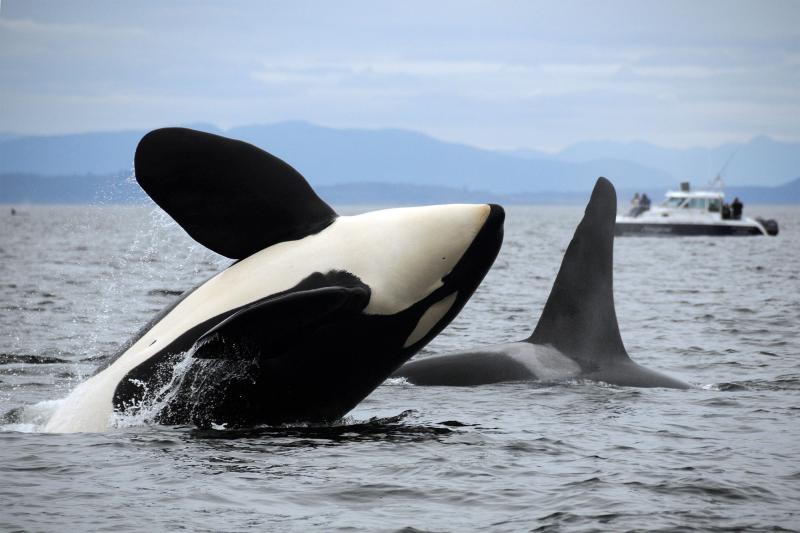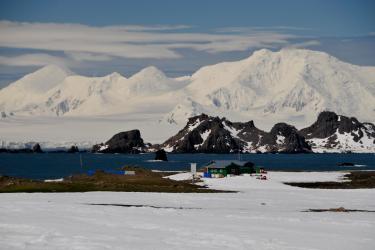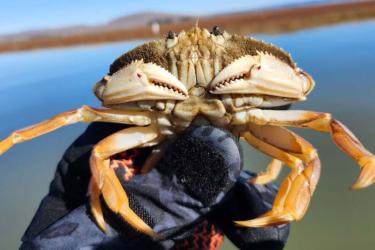Human impacts ranging from stray fishhooks to vessel strikes have killed more killer whales, including endangered Southern Resident killer whales, in the northeast Pacific Ocean than scientists had previously recognized. That is one finding of a new analysis of necropsy reports and body condition data from 88 North Pacific killer whales found dead since 2001.
The analysis focuses on the rare and valuable opportunities where researchers have examined orcas that have died. The study notes that many others die, and their bodies aren’t observed or recovered before they sink. It includes data from several populations of Northeast Pacific killer whales, including Southern Residents, transients, Northern Residents, and others that live farther offshore. In several cases, scientists could not determine the type of killer whale.
Understanding their causes of death can be very difficult, but it helps inform the species’ conservation. Scientists are especially interested in how many Southern Residents die of malnourishment. Lack of salmon prey has been considered an important limiting factor for this small population. The challenge is that without a necropsy, it is impossible to distinguish a whale that is malnourished from a lack of food from an animal that is malnourished due to disease.
That has been a lingering question in the case of J50, a juvenile Southern Resident that became thin and emaciated. J50 was the focus of an unsuccessful rescue effort in 2018. Biologists saw other whales with J50 feeding successfully. Southern Residents are also known to share prey, but J50 did not appear to be eating.
Because she had always been a small whale for her age, it’s possible that the young whale was born with a defect or disease and was never healthy enough to thrive, said Dawn Noren, a research scientist at NOAA Fisheries’ Northwest Fisheries Science Center who is a coauthor of the new analysis. Veterinarians had tried to administer antibacterial injections to J50 in the field, but there was no evidence that it benefited the whale. Scientists never identified a cause of death for J50 because her carcass was never found.
Few Examples of Starvation
Some fear that Southern Resident killer whales are starving from a lack of salmon. However, few true cases of starvation emerged among the killer whales analyzed for the new study. One case of starvation involved three transient killer whales that strayed up a large Alaskan river and could not find enough food in the freshwater to survive. Ultimately they became stranded on a sandbar.
However, many whales were either already decomposed when first discovered or could not be examined quickly enough to provide quality samples. In more than half of the cases, researchers could not identify a clear cause of death. Whales in thinner body condition may also be less likely to float or end up in locations where they can be found and examined.
Some conditions may also compound each other. For instance, malnutrition could make whales more susceptible to other risks such as disease, said Northwest Fisheries Science Center research biologist Brad Hanson, a coauthor of the new study.
“It can be hard to tease all the factors apart,” Noren said.
The researchers called for a consistent way to assess whales’ body condition that accurately reflects whether they are malnourished. Standard measurements such as blubber thickness are not definitive because the thickness increases with age and body length. It does not necessarily correspond to certain conditions, Noren said.
Eleven of the 88 killer whales showed signs of trauma, although the source of the trauma was unknown in some cases. About half of the killer whales killed by trauma were definitively attributed to vessel strikes. That surprised Noren, she said. While it may seem that intelligent and fast swimming killer whales could avoid vessel strikes, even they are not immune from the risk.
With a Southern Resident population of fewer than 100 animals, any death represents a significant loss, Noren noted. From 2002 to 2016, two Southern Resident killer whales (subadult L98 and adult J34) perished from collisions with vessels. Two others (adult L60 and subadult L112) died of trauma from unknown sources.
The case of L98 was unusual because he was separated from his family group and regularly approached vessels. The unknown sources of trauma affecting L60 and L112 remain a mystery. For younger whales, such as L112, they could be from a natural interaction like an attack by another killer whale.
Vessel Strikes an “Underappreciated” Threat
While the Southern Resident killer whale Recovery Plan and documents supporting vessel regulations mention vessel strikes, they had not been widely identified as a major threat. “This risk factor may be an underappreciated but important threat to the population status of endangered killer whales in the eastern Pacific,” the scientists wrote in the new analysis.
NOAA Fisheries has long identified three main risks to the Southern Residents:
- Limited salmon prey
- Contaminants
- Vessel noise and traffic
However, the new analysis shows that the causes of death for killer whales are even more diverse.
“When you are talking about a population this size, we cannot afford to overlook any sources of mortality,” said Lynne Barre, recovery coordinator for Southern Resident killer whales in NOAA Fisheries’ West Coast Region. “Our recovery program focuses on the three main threats, but this reminds us of how important it is to pay attention to other risks that we are learning more about.”
NOAA Fisheries has designated Southern Resident killer whales as one of nine national “Species in the Spotlight” that warrant focused attention. Biologists are preparing an update of the related action plan. The plan outlines recovery priorities, including developing individual health profiles for each whale to help track and understand their health and condition.
Scientists wrote in the new analysis that recovery efforts must address the risk of human interactions. That is true “especially for small endangered groups of killer whales that occur close to large human populations, interact with recreational and commercial fishers and transit established shipping lanes,” such as the Southern Residents.








